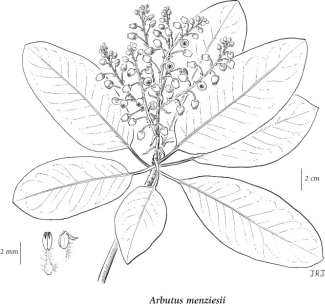Arbutus menziesii Pursh
arbutus (madrone; Pacific madrone)
Ericaceae (Crowberry family)
Introduction to Vascular Plants
arbutus (madrone; Pacific madrone)
Ericaceae (Crowberry family)
Introduction to Vascular Plants
Species Information
General:
Broadleaf tree, 6-30 m tall, often with many stems from the base and more shrublike; young bark chartreuse and smooth, aging to deep brownish-red and peeling off.
Leaves:
Alternate, evergreen, leathery, egg-shaped to elliptic, glabrous, entire on mature older growth, fine-toothed on young shoots, 5-15 cm long, dark shiny green above, whitish-green below.
Flowers:
In large drooping terminal clusters; corollas white or pinkish, urn-shaped, 6-8 mm long, fragrant.
Fruits:
Berries, globe-shaped, orange to red, about 1 cm across; surface finely granular.
Illustration

If more than one illustration is available for a species (e.g., separate illustrations were provided for two subspecies) then links to the separate images will be provided below. Note that individual subspecies or varietal illustrations are not always available.
Illustration Source: The Illustrated Flora of British Columbia
USDA Species Characteristics
Flower Colour:
White
Blooming Period:
Mid Spring
Fruit/Seed characteristics:
Colour: Red
Present from Summer to Fall
Source: The USDA
Ecology
Ecological Framework for Arbutus menziesii
The table below shows the species-specific information calculated from
original data (BEC database) provided by the BC Ministry of Forests and Range.
(Updated August, 2013)
The table below shows the species-specific information calculated from
original data (BEC database) provided by the BC Ministry of Forests and Range.
(Updated August, 2013)
| Site Information |
Value / Class |
||
|
Avg |
Min |
Max |
|
| Elevation
(metres) |
194 | 15 | 2080 |
| Slope
Gradient (%) |
21 | 0 | 135 |
|
Aspect (degrees) |
260 | 30 | 360 |
| Soil
Moisture Regime (SMR) [0 - very xeric; 4 - mesic; 8 - hydric] |
2 | 0 | 4 |
| Modal
Nutrient Regime
Class |
C | ||
| #
of field plots species was recorded in: |
74 | ||
| Modal
BEC Zone Class |
CDF | ||
|
All BEC Zones (# of stations/zone) species was recorded in |
CDF(52), CWH(20), ESSF(1) | ||
|
Source:
Klinkenberg 2013
|
|||